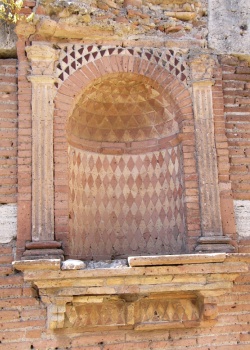Lararium
m (+ nav box) |
(recat) |
||
| Line 34: | Line 34: | ||
| − | [[Category: | + | [[Category:Roman religion]] |
Revision as of 14:43, 31 March 2009
Home | Latíné | Deutsch | Español | Français | Italiano | Magyar | Português | Română | Русский | English
⚜⚜⚜ Site Index - Key Pages ⚜⚜⚜
Lararium
Acerra - Gutus - Lucerna - Patera - Salinum - Turibulum
Reconstructionism in Nova Roma
Making a lararium
Simple rituals for starters
Daily rites - Kalends rites - Nones rites - Ides rites
The Lararium (pl. lararia) altar is the sacred place of the home where offerings and prayers are made to the Gods. In more affluent Roman homes, such as private villas, the main Lararium altar was usually set in the Atrium (front reception room, near the front door). In smaller Roman homes which might not have an atrium, such as insula apartments, the Lararium was most often located near the hearth (the kitchen or place of a central fire). But a house could have several minor Lararia as well, indoors (specially in the bedrooms) or outdoors.
Contents |
Variety of Forms
The forms of Lararium varied greatly. Rich homes might have a huge affair of carved marble which looked rather like a temple in miniature. In other homes the Lararium might only be a simple wooden cabinet or wall shelf. Big or small, the important thing about a Lararium is that it should be permanent rather than something to be put away when the rites are not being held.
A lararium, properly speaking, is a shrine for theLares. During the Republic there does not seem to have been any statues used to represent the Lares, since they were considered more as ancestors. The death masks of ancestors were stored in boxes, hung on a wall near the entrance of the house, and it might possibly be that lararium meant something like a foyer where these were kept. Today it would be comparable to having photographs of your ancestors at your lararium. Beginning in the fourth century BCE certain patrician families assumed divine heritages and thus may have begun to include images of a Lar familiaris such as Venus, but these would still have been regarded there as an ancestor.
Tools used at the lararium
- Acerra Container for incense.
- Salinum Container for salt.
- Gutus Container for milk or wine.
- Patera Offering dish.
- Incense An offering to the gods.
- Turibulum Incense burner.
- Lucerna Sacred lamp.
Examples
